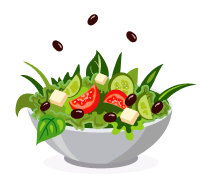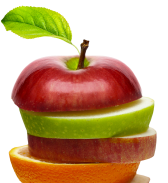Table Of Contents
Hey there, fitness enthusiast! Have you finally caved in and decided to try intermittent fasting but don’t know where to start? We get it; the number of fasting options and meal plans the Internet has come up with is mind-boggling. The 16:8 method, the 5:2 meal plan, the 20:4 approach – the list seems to be endless.
How does a fasting newbie like you take the most out of intermittent fasting and check whether it’s worth the hype? We’ve got you covered. Our nutrition experts have created diverse meal plans for every enthusiast willing to start a new diet, focusing on when and what to eat to keep you healthy and in terrific shape. Let’s set the stage for a healthier lifestyle, one fasting interval at a time!
What is Intermittent Fasting?
Intermittent fasting is a dietary pattern that involves eating at specific times and fasting in other periods. Even though this approach is more about when you consume, it is essential to stay mindful of what you eat, trying to incorporate healthier and more nutritious foods into your diet.
You eat your meals in a shorter time frame with intermittent fasting, which minimizes the frequency of your meals. Your body can effectively digest your food and reach the fat-burning stage required to lose weight or reap the other benefits of intermittent fasting. The benefits include improved glucose regulation, blood pressure, and heart rate, as well as the efficacy of endurance training.
An intermittent fasting meal plan will help you eat healthily and avoid extra calorie intake. 16/8 plan, 12/12 intermittent fasting schedule, 20/4 schedule – the choice is yours.
This flexibility and adaptability made this approach popular among fitness enthusiasts and celebrities. Everyone has been raving about IF lately, sharing their meal-skipping stories on TikTok, Reddit, Twitter, and all over the internet.
From Jimmy Kimmel to Hugh Jackman, from Elon Musk to your neighbors and classmates – you name it, everyone has tried IF so far. But what’s their secret? Let’s explore!
How to Schedule Meals? Your Body – Your Plan
You may have looked at different fasting methods and thought, “How do I manage that and find what works for me?” Scheduling your meals might seem overwhelming, especially if you have never done it before, but once you stick to it, the journey becomes easy and enjoyable.
Start with your current eating schedule. You probably already have one – you’re either eating right after you wake up, at 6-9 am or skipping breakfast and having your first meal at noon. This should be your starting point – there’s no need to starve in the morning if you’re used to enjoying your avocado toast and coffee before work.
Remember that there’s no one-size-fits-all approach. Intermittent fasting is meant to blend into your routine, not disrupt it seamlessly.
If you stay mindful of your body’s needs and not force the change, you’ll discover the IF approach that keeps you nourished throughout the day and allows you to fast with pleasure, not deprivation.

What to Eat and Drink During Your Fast?
Be mindful all the way – not only about when you eat but what you fuel your body with. Intermittent fasting is not one of those diets that ban all your favorite snacks and tell you to forget how chocolate tastes.
Intermittent fasting is like a trustful coach who doesn’t control your every move but believes in your willpower to eat healthier and be mindful of your choices. Do you want to snack on your favorite sweets? No problem! Do that in moderation, or switch to alternative, healthier, delicious versions!
When starting intermittent fasting, remember to focus on eating a cleaner, more nutritious diet, incorporating more protein, healthy fats, and veggies. And don’t forget to hydrate!
Here’s a simple guide on what to add to your meal plan:
1. Protein: Lean protein sources include turkey, chicken, fish, legumes, and tofu. Mix and match to make your diet more versatile, and don’t be afraid to try out new recipes!
2. Healthy fats: Include avocadoes, seeds, nuts, and olive oil. Pack your salads or sandwiches with them to sustain energy levels and support your overall health.
3. Vegetables: There are no restrictions on veggies whatsoever! Make salads loaded with tomatoes, bell peppers, cucumbers, leafy greens, broccoli, and other tasty greens. Your plates will now contain vitamins and minerals, keeping you nourished and full.
4. Whole grains: Don’t say goodbye to carbs! Switch to complex carbohydrates like wholewheat pasta, quinoa, brown rice, barley, and oats.
Also, read – 7 Reasons You Need to Drink Apple Cider Vinegar Every Night Before Bed – You’II Be Surprised!
5. Fruits: Choose lower-sugar options like berries, citrus fruits, and apples. Do you still want to snack on bananas or mangos? Feel free, but do it in moderation.
6. Hydration: H2O is your best friend in this journey! Drink water throughout the day, aiming for 3 liters a day. Herbal teas and black coffee are also allowed during fasting periods.
Intermittent Fasting Meal Plan Examples
Beginner Time-Restricted Fasting Plan
As a beginner, starting with the time-restricted fasting plan is a great way to begin this journey. The 16:8 method, in which you eat inside an 8-hour window and fast for the remaining 16 hours of the day, is the most popular type of time-restricted fasting. You can have three meals during the 8-hour eating window, while the 16-hour fasting time allows you to reach the fat-burning state.
Your 16:8 fast meal plan can look like this:
Breakfast: Green smoothie. Your breakfast can be at 7 am, 8 am, or 9 am, depending on your schedule. If you aren’t a breakfast person, your eating period can start at 12 pm or 2 pm.
Green smoothies are a tasty and nutritious way to start your day. Avocados, spinach, chia seeds, blueberries, and coconut milk make a fine green smoothie. Experiment and enjoy!
Lunch: One great option for lunch is taco salad or grass-fed burgers. Your snack can be any fruit of your choice or your favorite no-sugar sweets.
Dinner: Salmon and vegetables. Salmon is delicious and high in omega-3 fatty acids; vegetables are packed with antioxidants. Begin your fast by eating salmon with any roasted vegetables you prefer.
The next day, you eat even more nutritious food, saying “Thank you!” to your body and honoring its hard work. You can create a 7-day meal plan for intermittent fasting this way. The goal is to consume a diverse range of healthy and nutritious foods so your body receives all the nutrients it requires to attain your wellness goals safely.
16/8 Intermittent Fasting 7 Day Meal Plan
You don’t have to worry about creating new recipes for your 7-day meal plan; we’ve got you covered! With this meal plan, you can enjoy your favorite meals for 8 hours and dedicate 16 hours to effective fasting that will help revitalize your mind and body.
Here’s your 7-day meal plan for intermittent fasting:
Day 1:
Breakfast: Greek yogurt with your favorite berries, seeds, and nuts.
Lunch: A salad with mixed veggies, avocado, baked/grilled chicken, seeds, balsamic vinegar, and olive oil.
Dinner: Salmon with roasted veggies and quinoa.
Day 2:
Breakfast: Eggs (prepared the way you prefer) with spinach, feta cheese, hummus, and veggies.
Lunch: Chichen/turkey with brown rice and vegetables.
Dinner: Lentil soup with whole-grain bread.
Day 3:
Breakfast: Oats with milk of your choice, chia seeds, bananas, and nut butter.
Lunch: Salad with chickpeas, quinoa, avocado, tomatoes, cucumber, bell pepper, and lemon-tahini dressing.
Dinner: Couscous with baked/grilled tofu and baked/grilled veggies. You can also add a lemon-tahini sauce.
Day 4:
Breakfast: Protein smoothie with bananas, spinach, almond milk, and protein powder.
Lunch: Salad with corn, beans, cherry tomatoes, avocado, lime dressing, and your choice of leafy greens.
Dinner: Vegetable stir-fry with chicken/tofu and noodles.
Day 5:
Breakfast: Avocado toast with tomato salsa, poached eggs, feta cheese, and lemon dressing.
Lunch: A bowl with lots of veggies, chickpeas, quinoa, and tahini dressing.
Dinner: Grilled shrimp with grilled zucchini and couscous.
Day 6:
Breakfast: Chia seed pudding with bananas, mango, and coconut.
Lunch: Baked/grilled bell peppers with feta cheese, spinach, olive oil, and quinoa.
Dinner: Baked chicken with sweet potatoes and veggies on the side.
Day 7:
Breakfast: An omelet with mushrooms, onions, bell peppers, cherry tomatoes, and cheese.
Lunch: Chickpea salad with feta cheese, tomatoes, olives, cucumbers, and lemon and olive oil dressing.
Dinner: A steak with roasted veggies and wild rice.
Remember to stay hydrated every day and listen to your body; you can mix and match the intermittent fasting recipes, experiment with different recipes, and find what tastes the best.
2 Meals a Day Meal Plan
The idea of a 2 meals a day meal plan is not just to skip one meal but to restrict your caloric intake and help you achieve your weight loss goals. You can skip any meal, depending on your eating habits.
Here are a few ideas for a 2 meals a day breakfast and dinner plan to keep you nourished and happy throughout the day:
Meal 1
Start your day with a nutritious breakfast or brunch.
Option 1: Scrambled eggs with feta cheese, spinach, mushrooms, veggies, and whole-grain toast.
Option 2: Oats made with milk of your choice, chia seeds, bananas, nuts, and nut butter.
Meal 2
Enjoy a warm, flavorful dinner to fuel your body and prepare for a fast.
Option 1: A chicken salad with loads of veggies, chickpeas, feta cheese, leafy greens, olive oil, and balsamic vinegar.
Option 2: Grilled salmon with herbs and lemon, roasted sweet potatoes, broccoli, and salad.
The 5:2 Meal Plan
The modified two-day meal involves eating normally five days a week and cutting your calorie intake to about a quarter of your daily needs. For most people, this is about 500 calories. The days you cut down your calorie intake are your fasting days, and you should fast for two
days non-consecutively in the week.
Your fasting plan could look like this:
Monday: Fast.
Tuesday: Eat normally. Your food should include fruits, vegetables, clean meat sources, and healthy fats.
Wednesday: Eat normally. Your food should include fruits, vegetables, clean meat sources, and healthy fats.
Thursday: Fast.
Friday: Eat normally. Your food should include fruits, vegetables, clean meat sources, and healthy fats.
Saturday: Eat normally. Your food should include fruits, vegetables, clean meat sources, and healthy fats.
Sunday: Eat normally. Your food should include fruits, vegetables, clean meat sources, and healthy fats.
Remember to stay hydrated on fasting days.
Alternate Day Fasting Meal Plan
This fasting method involves fasting every other day. You usually eat for a day, fast the next day, and continue the trend. On fasting days, you can consume water, herbal tea, and moderate amounts of black coffee or tea.
Your alternate-day fasting meal plan will look like this:
Monday: Eat normally. Your food should include fruits, vegetables, clean meat sources, and healthy fats.
Tuesday: Fast.
Wednesday: Eat normally. Your food should include fruits, vegetables, clean meat sources, and healthy fats.
Thursday: Fast.
Friday: Eat normally. Your food should include fruits, vegetables, clean meat sources, and healthy fats.
Saturday: Fast.
Sunday: Eat normally. Your food should include fruits, vegetables, clean meat sources, and healthy fats.
High Protein Intermittent Fasting Meal Plan
If you workout regularly and want to build those abs, intermittent fasting can help you see results faster if you stick to its high-protein version. Build your abs not just in a gym; do it in the kitchen, too!
Also, read – Intermittent Fasting and Alcohol: Does Alcohol Break a Fast?
This is a high-protein intermittent fasting meal plan example:
Meal 1 (Midnight): Protein-Packed Breakfast
Scrambled eggs with tomatoes, chicken, feta cheese, and whole-grain toast. Another option is to make a protein-packed smoothie with bananas and peanut butter. With a high-protein breakfast like this, you’ll forget about cravings during the day and have loads of energy to power through anything.
Meal 2 (3 PM): Lean Protein Lunch
Enjoy grilled chicken breast with quinoa and a salad on the side. You can also prepare brown rice and eat it with tofu, chicken, or turkey.
Meal 3 (6 PM): High-Protein Dinner
Bake your preferred fish and serve with sweet potato wedges and sautéed green beans or broccoli. Another option is to make a lentil stew with your favorite veggies.
Vegetarian Intermittent Fasting Meal Plan
Intermittent fasting paired with a vegetarian diet can provide incredible health benefits, but you should be mindful of your protein consumption and nourish your body correctly. Here are intermittent fasting meal ideas featuring three tasty, fun, and healthy plant-based meals for your IF journey:
Meal 1
An avocado toast on a whole-grain bread. Pair it with cherry tomatoes, feta cheese, eggs (if you eat them), and spinach or arugula. Sprinkle the toast with tahini dressing and lemon. Pait it with black coffee or herbal tea.
Meal 2
Lentil soup with veggies, tofu, and spices of your choice. Add baked crispy chickpeas and balsamic vinegar for extra flavor and crunchiness.
Meal 3
Roasted tofu, veggies, and chickpeas bowl with sweet-chilly sauce and tahini dressing. Add roasted sesame seeds and lemon juice on top.
Finish your day with relaxing camomile tea for a calm evening.
Art of Fasting: an Intermittent Fasting Menu
Do you need extra inspiration for your healthy and delicious intermittent fasting menu? Our nutritionists have prepared some intermittent fasting meal ideas for you to experiment with and unlock the full potential of the fasting journey.
Intermittent Fasting Breakfast for an Energy Boost
Avocado and Egg Bowl
Use quinoa or brown rice and top it with avocado, poached eggs, favorite veggies, feta cheese, seeds, and spices. Enjoy!
Overnight Oats with Chia and Bananas
Soak oats in Greek yogurt or almond milk, add chia seeds for extra fats, and refrigerate it overnight. Top the oats with fresh berries, banana, and peanut butter, and stay full till lunch.
Greek Yoghurt Parfait
Cover Greek yogurt with berries, almonds, or other nuts, and drizzle this tastiness with honey and tahini. This is both a protein-packed breakfast and a sweet and delicious snack option.
Green Smoothie
Blend a banana, spinach, kale, alimony milk, and your favorite protein powder, and drink this smoothie as you get ready in the morning or on the go as you walk in the park.
Intermittent Fasting Lunch Ideas: Savor Every Bite
Veggie-Loaded Chicken Salad
A salad shouldn’t be boring! Elevate your everyday green bowl with grilled chicken breast, broccoli, cherry tomatoes, and avocado, and add a dressing of your choice: mustard and lemon with olive oil, tahini, greek yogurt, and herbs, or any other light and tasty option.
Quinoa and Vegetables Stir-Fry
Stir-fry veggies with quinoa and tofu, add soy sauce or sweet chili sauce, and sprinkle everything with roasted seeds and a bit of sriracha for some spiciness.
Tuna Salad Wraps
Mix canned tuna in brine with diced bell peppers, Greek yogurt, mustard, and lemon, and wrap this into salad leaves or a whole-wheat tortilla wrap.
Intermittent Fasting Dinner Ideas
Vegetarian Chilli
Beans, tomatoes, bell peppers, onions, and spices simmered together to make a warm and cozy vegetarian chili perfect for an evening meal at home.
Eggplant Parmesan
This easy intermittent fasting meal plan can also include eggplant parmesan! Slice an eggplant, layer the slices with tomato sauce, mozzarella cheese, and parmesan, and bake until golden brown. This is a vegetarian version of lasagna.
Fish with Roasted Veggies
Bake your favorite fish fillets with slices of lemon and herbs of your choice. Serve the fish with brown rice, quinoa, roasted veggies, and a fresh salad.
Wrapping Up: Time to Fast!
Think of your intermittent fasting journey as a joyful and exciting exploration of new recipes, your body’s needs, and different fasting schedules. It’s not about skipping meals – it’s about eating more nourishing foods and effectively allowing your body to use energy sources, including body fat.
So, intermittent fasting meal plan for weight loss shouldn’t be boring and repetitive; it can turn you into a creative chef, coming up with new meals every day, mixing the ingredients, and trying new recipes. Let your kitchen become your canvas, where you can explore and express your creativity and feed your body with delicious meals.
With every fasting period, your body will adapt more, and your task is to listen to its cues, prioritize healthy foods, and hydrate. Stay curious and open; this journey will bring you closer to your wellness goals!
Kimberly Tytyk is a Certified Integrative Nutrition Health Coach (INHC) and a Certified International Health Coach (CIHC). Following decades of personal experience transforming her personal health and achieving remission of autoimmune thyroiditis and PCOS, Kimberly completed her formal coaching training in 2021 at the Institute of Integrative Nutrition. Her passions include deep nutrition, holistic and balanced living practices, regeneration, community-building, and finding bliss — usually in a cuddle with her husband and dog.










Thanks for breaking down the essentials of an intermittent fasting meal plan! It’s amazing how this eating strategy can blend health goals with mindful consumption.
Hi, Emma!
Glad you found the breakdown helpful! 😊 Intermittent fasting does indeed offer a great balance between health and mindful eating. 🌿🍽️